Lombok's #1 Tourism Magazine
The tradition of weaving cloth in Pringgasela is so old no one quite knows where the original idea came from. All that the people of Pringgasela know is that weaving is the life-blood of their village and has been practiced for as long as anyone remembers.
The village of Pringgasela is located in East Lombok, around 65kms and around two hours’ drive from Senggigi. Together with the village of Sukarare in Central Lombok, it is famous throughout Indonesia for the traditional woven fabrics known as Ikat and Songket.
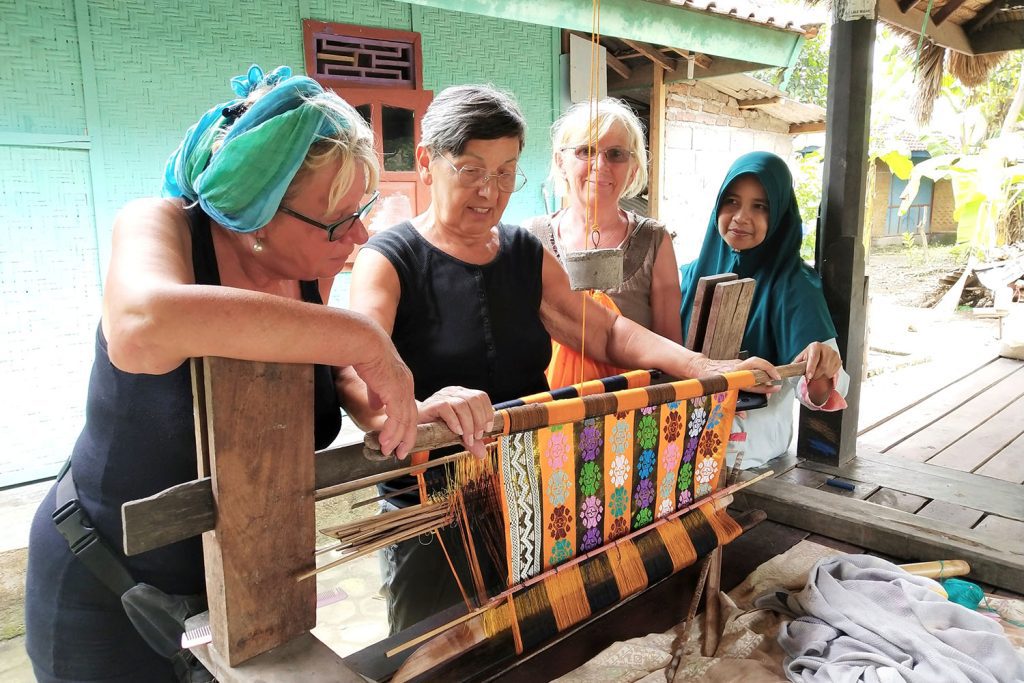 There are many art shops in Pringgasela displaying different types of woven cloth for sale, but it is in the warren of small side streets that run through the village that visitors can get a close up look at the processes involved in creating this precious cloth.
There are many art shops in Pringgasela displaying different types of woven cloth for sale, but it is in the warren of small side streets that run through the village that visitors can get a close up look at the processes involved in creating this precious cloth.
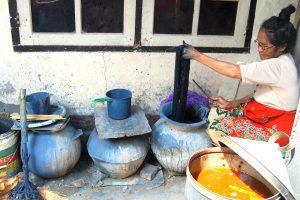
Weaving is the principle occupation for people living in the village; almost every home is involved in the craft, whether it be dyeing the threads to be used by weavers, spinning the yarn and preparing it for the looms, or weaving the thread into cloth.
Girls in the village are taught to weave by their mothers who, in turn, learnt from their mothers… in a tradition stretching back countless generations. By the time they are 12 years old, most girls can use the looms used to weave cloth.
The women of the village spend around 6 hours every day weaving, depending on the demands of their family and what pieces they are working on. An average ikat takes around one month to create.
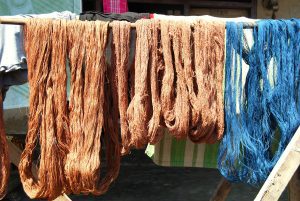 Ikat is a highly prized art form throughout Indonesia and by collectors around the world, and some of the best forms are produced in Pringgasela and Sukarare in Lombok. Lombok ikat is often sold in Bali at many times its real cost, so the best place to buy is from the villages.
Ikat is a highly prized art form throughout Indonesia and by collectors around the world, and some of the best forms are produced in Pringgasela and Sukarare in Lombok. Lombok ikat is often sold in Bali at many times its real cost, so the best place to buy is from the villages.
It is also a disappearing art form, as cheap cloth produced by machine replaces fabric used by local societies. However, it is still used in traditional ceremonies, such as weddings and customary rituals, and in the past few years has seen a revival, thanks to Jakarta fashionistas and designers, who are using traditional cloth to make stylish and modern new fashions.
Pringgasela is one of the few villages where the threads are still dyed using natural dyes, although this is rapidly being replaced by synthetic dyes, which are much easier, faster and cheaper to produce.
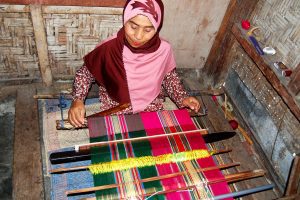
Dying is a complicated process that can take years to perfect. Natural dyes are produced from ingredients such as leaves, flowers, roots and bark, and the process to achieve a desired colour is very intensive.
In Pringgasela, tarum leaves are boiled to produce a beautiful indigo blue, while bark from the Makassar tree is used to produce browns and creams. Threads are also sometimes left natural, to accent different colours and patterns, or naturally dyed threads are combined with synthetically dyed threads to incorporate colours the village cannot produce, such as bright red or yellow.
Dyed thread (whether natural or synthetic) is then wound onto spools using old fashioned spinning wheels. In one home we visited, an old lady wound the spools on an old wooden spinning wheel mounted with a bicycle wheel, carefully keeping the tension tight and overlaying layers of thread with an ease born of years of practice.
In another home, a lady carefully set up the rods that would be used in the looms, counting and arranging threads that will later make up the intricate patterns woven into the fabric.
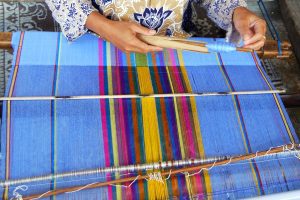 The contraption used to weave the cloth is called a “back-strap loom” and looks like a museum-piece. The weaver sits inside the wooden frame and the loom is balanced on the front of her body. A rod with a wooden piece to support the small of her back is connected to the loom. The weaver controls the tension on the loom with her body by leaning slightly back against the wooden piece at her back. This can’t be easy to sit in for up to 6 hours!
The contraption used to weave the cloth is called a “back-strap loom” and looks like a museum-piece. The weaver sits inside the wooden frame and the loom is balanced on the front of her body. A rod with a wooden piece to support the small of her back is connected to the loom. The weaver controls the tension on the loom with her body by leaning slightly back against the wooden piece at her back. This can’t be easy to sit in for up to 6 hours!
Fabric is then woven by moving the wooden rods to pull the threads down (the warp) and threading the spindle through the vertical fibres to create the weft, fusing the threads together.
The resulting fabric is a strong, beautiful cloth, which resembles fine linen in natural colours such as white, cream, chocolate and blue.
The fabric is then washed in air ketan (rice water) to preserve the colours. It may seem stiff at first, but will become softer with repeated washing and will last for many years.
The textiles woven in Lombok are traditionally “Sasak inspired ” (Lombok ethnic) with more earthy colours than the cloth produced in Bali. The motifs or patterns are also diverse, representing rice fields, flowers, chickens, geckos, butterflies and other creatures. Some of the older patterns even tell stories about adat (custom) and traditional values.
Some expensive fabrics, called songket, combine silver or gold threads woven into the design. The metallic threads stand out against the background cloth to create a shimmering effect.
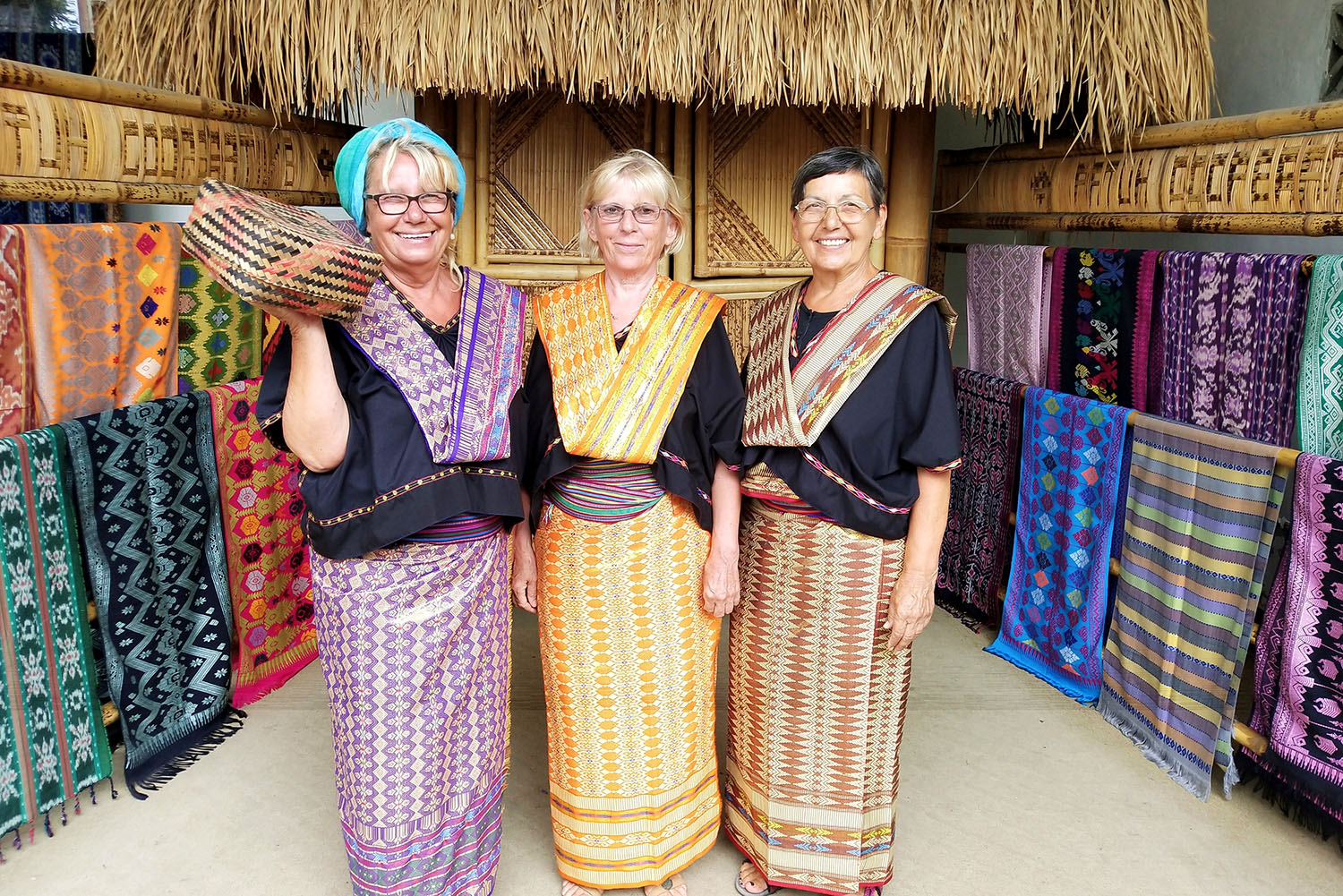 The usual size sold in Lombok is 60cm wide x 450 cm long, as that is the maximum size that can be made on the looms. Material can be cut into smaller pieces, or sewn together to make larger pieces, and is made into scarves, shawls, belts, clothing and, of course, the essential sarong.
The usual size sold in Lombok is 60cm wide x 450 cm long, as that is the maximum size that can be made on the looms. Material can be cut into smaller pieces, or sewn together to make larger pieces, and is made into scarves, shawls, belts, clothing and, of course, the essential sarong.
The larger, thickly woven pieces make beautiful blankets and bed covers, or a fascinating piece to hang on the wall.
Generally expect to pay between Rp 350 – 800,000 for naturally dyed pieces, and Rp 250 – 500,000 for chemically dyed fabrics, depending on the size and motifs used. Intricate pieces can be much more expensive. The older ikat and songket found in villages is highly prized by collectors and can be very expensive, as many are museum quality.